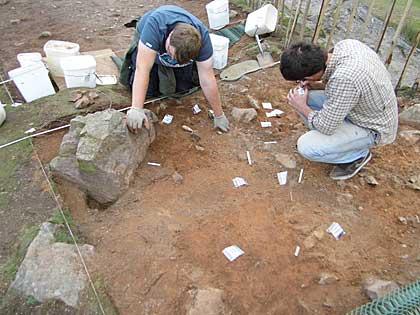Source - http://www.culture24.org.uk/history-and-heritage/archaeology/art539462-upper-palaeolithic-pompeii-site-in-leicestershire-yields-archaeological-evidence-of-ice-age-economic-migrants
A very rare camp from the Upper Paleolithic period is yielding a plethora of flint deposits left by Ice Age hunter gatherers
 A stout piercer. These are the most common find at the site and were possibly used for heavy-duty work on materials like hide or antler.© ULAS
A stout piercer. These are the most common find at the site and were possibly used for heavy-duty work on materials like hide or antler.© ULAS
Archaeologists from the University of Leicester think they may be on the cusp of discovering tangible evidence of economic migrants to Britain during the Ice Age.
After being hidden for nearly 15,000 years, the lives of Ice Age hunter-gatherers who migrated to Europe to benefit from warmer climes are being revealed in the archaeological dig at a very rare site in Bradgate Park, Leicestershire.
Analysis of the flint scatter left by the hunter gatherers by a team from the University of Leicester Archaeological Services (ULAS) at the rare Late Upper Palaeolithic site has revealed a plethora of worked flint in different activity zones that may give the archaeologists an understanding of the dynamics of camp life some 14,700 years ago.
According to Lynden Cooper, Principal Investigator on the project, the ancient people who left behind these clues were “members of a small group of pioneer mobile hunter gatherers who repopulated north-west Europe towards the end of the last Ice Age with the rapid onset of a warmer climate (the Lake Windermere Interstadial) and the development of open grassland vegetation”.
 A flint projectile point that would have tipped a long dart, propelled by an atlatl ('spear thrower')© ULAS
A flint projectile point that would have tipped a long dart, propelled by an atlatl ('spear thrower')© ULAS
“The new environment attracted a rich fauna of large vertebrates including wild horse and red deer, two of the preferred prey species,” added Cooper. “Other species included mammoth, elk, wild cattle, wolf, arctic fox, arctic hare and brown bear.
“They were re-colonising lands that had been lost for circa 10,000 years - economic migrants in a period of rapid global climate change, if you like.”
The ULAS team is carrying out a full excavation in order to record the nationally important Upper Paleolithic site, which Copper describes as “the equivalent of a Pompeii” that will allow archaeologists to preserve a “record of human existence from a snapshot in time millennia ago”.
The rare preservation of the hunters’ campsite is due to the creation of the medieval deer park which has not been cultivated.
“In the 19th and earlier 20th century excavation of caves such as at Creswell Crags and Cheddar Gorge provided the first evidence for the archaeology of this period but open air sites were missing pieces of the jigsaw,” added Cooper. “In recent years we have started to identify such sites allowing research of hunter-gatherer behaviour in the open environment.”
A designated Site of Special Scientific Interest for its rare geology and wet heath habitats, Bradgate Park is also a Country Park included on the register of Parks and Gardens of Special Historic Interest. It boasts two Scheduled Ancient Monuments and five listed buildings which includes Bradgate House and Old John.
The latest work, which is being funded by Bradgate Park Trust, has been made possible by a grant of financial support from Natural England and ‘in kind’ support from Historic England. The excavation is taking place during October to December with subsequent analysis and reporting in 2016 – 2017.
 ULAS archaeologists start to excavate the central area of the artefact scatter© ULAS
ULAS archaeologists start to excavate the central area of the artefact scatter© ULAS